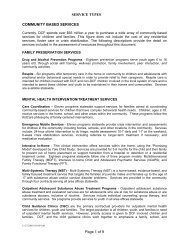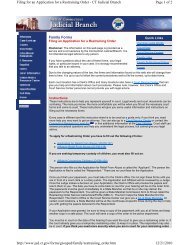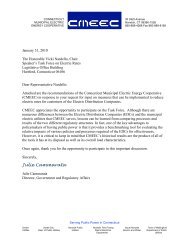Rob Thieler from U.S. Geological Survey Presentation - Connecticut ...
Rob Thieler from U.S. Geological Survey Presentation - Connecticut ...
Rob Thieler from U.S. Geological Survey Presentation - Connecticut ...
You also want an ePaper? Increase the reach of your titles
YUMPU automatically turns print PDFs into web optimized ePapers that Google loves.
We need better science* to prepare our local responses toclimate change, especially in our coastal areas.(David Carter, Delaware Coastal Management)*science = better understanding of processes + better situation awareness
Past, Current and Projected GlobalTemperatureThe last 10,000 years have been ideal forthe development of human societies.This has been a unique time duringwhich climate varied very little andenabled humankind to flourish.
Sea-level rise rates since the Last GlacialMaximummwp-Iamwp-IbGlobal delta initiation(Stanley and Warne, 1994)U.S. Atlantic, U.K.wetland initiation;barrier island stability(Shennan and Horton, 2002;Engelhart et al., in press)Rate of SLR (mm/yr)Thousands of 14 C years before present(SLR rate based on Fairbanks, 1989)
Past, present, and potential future rates ofsea-level rise“Geologic past”(Fairbanks, 1989;Horton et al. 2009)“Projections”(Rahmstorf, 2007)“Instrumental record”(Church and White, 2006)Rate of SLR (mm/yr)Years before present
Historic and Projected Sea-level RiseIPCC AR4A1B envelopeSeveral projections suggest ~60-150+cm rise is possible over the next century(modified after Rahmstorf, 2007; A1B envelope <strong>from</strong> IPCC, 2007)(modified after Rahmstorf, 2007; AR4 data <strong>from</strong> Bindoff, 2007)
Issue: Global variability in SLREarth is still undergoingisostatic adjustment<strong>from</strong> deglaciation(Illinois <strong>Geological</strong> <strong>Survey</strong>)(Horton et al., 2009)
Issue: Global variability in SLRLoss of the WestAntarctic Ice Sheet cancause up to 25% moreSLR on the U.S. coast.(Eric Steig)(Bamber et al., 2009)
Issue: Regional variability in SLR(Yin et al.,2009)(Hu et al., 2009)Regional changes in circulation and ocean warming can increasesea level by tens of centimeters, for example in the northeasternU.S. (north of Cape Hatteras).
Importance of Spatial Scale
Importance of Temporal ScaleShort Term VarianceShoreline PositionSeawardLong TermTrendTimeShort-term Variance(hours to decade)Storm impact/recoveryAnnual cyclesEl NiñoLong-term Trend(decades to centuries)Sediment deficit or surplusSea-level rise
Coastal Vulnerability to Sea-level Rise:A Preliminary National Assessment(<strong>Thieler</strong> and Hammar-Klose 1999, 2000a, 2000b)Vulnerability Ranking
Coastal Sensitivity to Sea-Level Rise:A Focus on the Mid-Atlantic RegionU.S. Climate ChangeScience ProgramSynthesis and AssessmentProduct 4.1
Coastal Elevation Data• Elevation is a critical factor inassessing potential impacts(specifically, inundation)• Current elevation data do notprovide the degree of confidenceneeded for quantitativeassessments for local decisionmaking• Collection of high-qualityelevation data (lidar) would bevaluable(Gesch et al., 2009)
Coastal Elevation Datain <strong>Connecticut</strong>(Walters, USGS NE lidar program)
Eastern North Carolina0 15 30 60 90 120KilometersElevation source: 30-m DEMElevation source: 3-m lidar dataDark blue Land ≤ 1 meter elevationLight blue Area of uncertaintyassociated with 1 meter elevation• High quality elevation datareduce uncertainty of potentiallyinundated areas(Gesch et al., 2009)
Coastal Flooding in Charleston, SC(Built environment impacts)• NOAA NWS Charlestonissues shallow coastalflooding advisories for 7 fttides• 7 ft tides typically predictedto occur twice a year(NOAA CSC)• With 1.6 ft of relative sealevelrise, this advisorycould be issued 355 timesper year
But… the coast is not like a bathtubMiamiNew YorkBoston
Mid-Atlantic Assessment of PotentialDynamic Coastal Responses to Sea-level RiseBluff erosionOverwashIsland Breaching(Gutierrez et al., 2009)Threshold Crossing
Coastal Wetlands RespondDynamically to Environmental ChangeR. CarlsonWetland Vertical DevelopmentMineral sediment depositionPlant matter accumulation - soil(root production/decomposition)CompactionShrink-SwellD. Cahoon(Cahoon et al., 2009)D. Cahoon
So, what can happen?Bluff erosionOverwashIsland BreachingListedSpeciesImpactsThreshold CrossingUrban InundationWetland LossR. CarlsonWater Quality ReductionEcosystem ChangeInfrastructure Failure
Science strategy to address the challengeof climate change and sea-level riseMonitor ModernProcesses andEnvironmentsLearn <strong>from</strong>the PastImprove PredictiveCapabilityImprove Understandingof Societal ImpactsSupport Decision Making(<strong>Thieler</strong> et al., 2009)
Informing Decisions in a Changing ClimateNational Research Council (2009)The end of “Climate Stationarity” requires thatorganizations and individuals alter their standardpractices and decision routines to take climatechange into account. Scientific priorities andpractices need to change so that the scientificcommunity can provide better support todecision makers in managing emerging climaterisks.• Decision makers must expect to be surprisedbecause of the nature of climate change andthe incompleteness of scientificunderstanding of its consequences.• An uncertainty management frameworkshould be used because of the inadequaciesof predictive capability.
Sea-level rise impacts: A multivariate problem withuncertainties everywhereDrivingForcesGroundwaterImpactWetland LossHabitat LossAdaptationPlanningResponseClimate Change&Sea LevelRisePhysical& BiologicalProcessesCoastal ErosionPotentialImpactsManagementDecisionsInitialConditionsInundationSafety
Mapping Erosion Risk Using Bayesian NetworksProbability of shoreline erosion >2 m/yrNew YorkBostonD.C.CharlestonMiami(Gutierrez et al., 2011)
Mapping Prediction UncertaintyHigher probability = higher certainty of outcome• Uncertainty map can beused to identify wherebetter information isneeded• Areas of low confidencerequire• better input data• better understanding ofprocesses• Can use this map tofocus researchresources(Gutierrez et al., 2011)
Summary• Future sea-level rise is problematic• It is a certain impact (we have already made a commitment toseveral centuries of SLR)• It is an uncertain impact (rates and magnitudes poorlyconstrained; human response unknown)• Effective climate change decision support willrequire changes in how we do science and howdecision makers assimilate and use scientificinformation• Probabilistic approaches have many applications• Convey what we know and what we know we don’t know• Synthesize data and models• Provide basis to focus research resources• Furnish information to support decision-making












